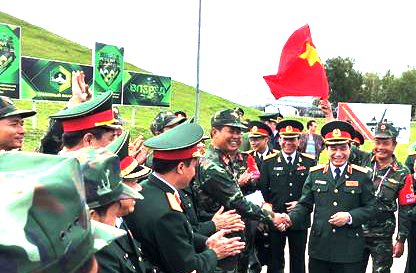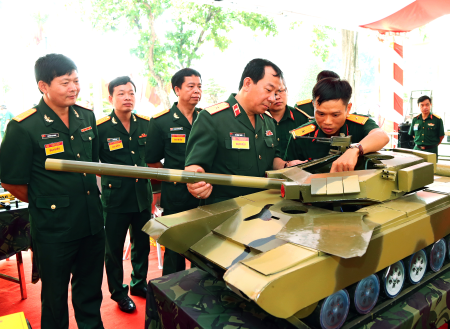To satisfy the requirements set by the Homeland protection in the new period, the Tank-Armoured Corps has actively been made compact, strong and capable of undertaking and successfully fulfilling all assigned missions as an important raiding unit of the Vietnam Ground Force.
Grasping the Party’s guidelines on building a revolutionary, regular, elite, gradually modern Vietnam People’s Army, with several forces moving straight to modernity, and particularly the Central Military Commission’s Resolution 606-NQ/QUTW, dated June 6th, 2018 on realising the Politburo’s Conclusion 16-KL/TW, dated July 7th, 2017 on the organisation of the Vietnam People’s Army towards 2021, over the years, the Tank-Armoured Corps’ Party Committee and Command have synchronously, drastically adopted measures for building compact, strong units on a par with their task requirements and achieved many significant results. Preparations have been made closely, carefully, scientifically. Importance has been attached to conducting the work of propagation and education to achieve a consensus amongst cadres, party members, and the masses. The Corps’ competent offices have proactively undertaken researches on the organisational structure of all affiliated offices and units, merger and dissolution of several offices, units, and schools as well as the establishment of some units to meet the requirements set by the building of the Tank-Armoured Force in the new period. Grounded on such researches, they have proposed the adjustment plans, projects, and roadmap so that the Corps’ Command would submit them to the Ministry of National Defence for approval. At the same time, emphasis has been placed on renewing training and exercises, raising combat readiness capacity, developing the combat art of the Tank-Armoured Force, and providing logistics, technical, and financial support for all missions.
 |
| Leader of the Ministry of National Defence congratulating Vietnam’s Tank Team on its achievement at the International Army Games of 2020 |
At present, the Corps’ organisational structure has been adjusted in a compact, strong manner. The rate of redundant troops within campaign-level has been controlled. However, to satisfy the requirements set by the Homeland protection in the new period, the Corps’ Party Committee and Command will continue grasping and successfully implementing the guidelines and tasks set by resolutions of all-level party congresses and especially building a modern Tank-Armoured Corps towards 2030. To that end, the Corps will focus on several basic measures as follows.
First, build a politically strong Corps as the basis for improving its raiding power. All-level party committees and commands shall grasp and execute the Resolution of the 11th Military Party Congress, higher echelons’ resolutions, directives and regulations on the Party building, the Politburo’s Directive 05-CT/TW on the study and following of Ho Chi Minh’s ideology, ethics and lifestyle as well as programmes and campaigns, particularly the Campaign titled “promoting tradition, devoting talent, deserving to be Uncle Ho’s soldiers” in the new period, while resolutely preventing “self-evolution” and “self-transformation” from within. Due attention should be paid to maintaining and improving Party meetings, the principle of democratic centralism, and regulations on self-criticism and criticism to create a huge positive change in leadership capacity and combativeness of each party committee and cell. It is necessary to make party organisations pure and strong, build comprehensively strong, “exemplary, typical” offices and units, and consolidate party committees and a contingent of key cadres at all levels.
In addition, offices and units should concentrate on renewing and improving political education, ideological management, and legal dissemination, propagation and education to achieve a change in cadres and soldiers’ awareness and responsibility. In this regard, greater importance should be attached to educating troops on Marxism-Leninism, Ho Chi Minh’s ideology, the Party’s guidelines, the tasks of the Military and the Corps, and the strategy to build the Corps in both long and short terms. It is essential to grasp and manage troops’ ideology to prevent ideological issues from negatively impacting on offices and units’ combat strength and readiness. Doing so will help build up all troops’ political zeal and iron will against all difficulties and enable them to identify “partners” and “opponents,” remain revolutionary vigilance, and effectively deal with situations. Moreover, it is important to well carry out the work of internal political protection and proactively fight against wrong, hostile viewpoints to defend the Party’s ideological foundation within the Corps. Due attention should be paid to promoting the role of mass organisations and soldiers’ councils in implementing the Regulation on democracy at grass-roots level and supervising the execution of party organisations’ guidelines and commanders’ orders. The internal unity and the relationship between the Military and the people should be cemented while a healthy military cultural environment should be created for troops’ self-improvement.
Second, enhance measures to build a compact, strong Corps capable of meeting its task requirements. To do so, consideration should be given to realising resolutions of all-level party congresses and advising the Central Military Commission and the Ministry of National Defence on developing the Tank-Armoured Force in accordance with defensive zones, campaign and strategic level combat projects, and its organisational structure, materiel, and combat method. It is vital to seriously execute decisions and directives by the Ministry of National Defence on the organisation of the Tank-Armoured Force, particularly the Decision 08/QĐ-TM, dated January 6th, 2020 by the Chief of the General Staff on the Tank-Armoured Corps Command’s new structure and the Project on modernising this Force towards 2020 and beyond. Emphasis should be placed on reorganising the Tank Non-Commissioned Officer School No.1 into the Tank-Armoured Brigade No.3 and establishing the Tank-Armoured Brigade No.4. In the process, offices and units should focus on encouraging the role of party organisations and their heads, well conduct the ideological, organisational and policy work, and reduce 10% of the strength of divisions and committees under the Corps Command. By 2025, the general force adjustment will have been completed. From 2030, the entire Corps will be modernised. Measures should be enhanced to improve cadres and employees’ professional competence, renew their work method and the recruitment of new staff members, and discharge individuals with poor task performance. Due regard should be paid to fighting against the impatient, subjective, flippant implementation of the Corps’ rearrangement plan.
 |
| Commander of the Corps inspecting training equipment |
Third, renew and improve the training quality and combat readiness capacity. Offices, units, and schools within the Corps should grasp and effectively execute the Party’s military-defence guidelines and viewpoints, especially the Central Military Commission’s Resolution 765-NQ/QUTW and the Resolution 438-NQ/ĐU by the Corps’ Party Committee on “raising the quality of training in the period of 2013-2020 and beyond” in tandem with the Project on “renewing political education at military units in the new period.” Personnel and facilities for the training work should be carefully prepared. At the same time, it is necessary to comprehensively and drastically renew the contents, forms, and methods of training and exercises, flexibly apply viewpoints, connections and mottos in the training process, organise training courses relevant to combat reality, and place emphasis on training troops to master new weapons, equipment and tanks. Significance should be attached to night-time, joint combat, and field training courses in accordance with the characteristics of each area and the organisational structure and task of each unit. Due attention should be paid to holding competitions and taking part in international tank-armoured contests so as to gain experience and increase the quality of training in response to the requirements set by modern warfare. Offices and units should enhance inspection and investigation of training and resolutely overcome the “merit-driven disease” in the training process, while combating dishonest reports on training results and a reduction in the training contents and duration. At the same time, they should organise conferences to review their training work and exercises, point out weaknesses, draw lessons, and propose measures for improving the training quality in the following periods.
Furthermore, offices and units should review, develop and adjust their combat plans and their projects for natural disaster prevention and control and search and rescue in accordance with their particularities and task. Great weight should be added to organising joint exercises with other forces in the stationed areas to well settle situations. Besides, due attention should be paid to undertaking more researches on developing the art of force use and the Tank-Armoured Corps’ combat method during defensive operations, force manoeuvre and the fight against enemies’ hi-tech warfare and riots. New contents and information should be included in training documents and textbooks for troops.
Fourth, provide logistics and technical support for the building of a compact, strong Corps. In order to deal with the degeneration of weapons and technical equipment, offices and units across the Corps should keep grasping and well implementing the Campaign 50, bring into play the spirit of self-reliance, proactively develop and realise their technical support plans in a comprehensive but focalised manner. It is vital to continue acquiring, receiving and mastering new tanks as well as manufacturing and upgrading the existing tanks and armoured vehicles simultaneously. Resources from higher echelons and the Corps should be exploited to construct, upgrade and standardise the system of depots and technical zones in order to increase repair stations and workshops’ capacity for missions. Due attention should be paid to enhancing the emulation movement entitled “the Military Logistics Branch follows Uncle Ho’s teachings” and regularly, sufficiently maintain the reserves of logistics materials for combat readiness and routine and contingency tasks, with priority given to training, exercises, and search and recue. The method of logistics support should be renewed in a direct, sufficient, timely fashion while troop fitness should be improved to ensure the strength for missions. Budgets allocated by higher echelons and on-the-spot resources should be effectively used to better troops’ daily life while fuel and finance should be opportunely provided for missions and closely managed to prevent corruption, wastefulness and negative practices.
The successful implementation of the above-mentioned measures will help concretise resolutions of all-level party congresses into the building of a compact, strong Tank-Armoured Corps capable of defending the Homeland in the new period.
Maj. Gen. DO DINH THANH, Commander of the Tank-Armoured Corps